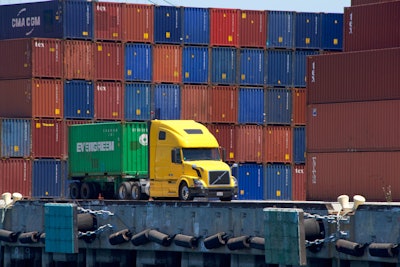 While much is unknown about the novel coronavirus spreading throughout China and other parts of the world, there have been no reports as yet of the virus spreading by living on surfaces, such as freight and shipping containers coming from China.
While much is unknown about the novel coronavirus spreading throughout China and other parts of the world, there have been no reports as yet of the virus spreading by living on surfaces, such as freight and shipping containers coming from China.There are still many unknowns about the novel coronavirus that originated in Wuhan, China, in December, but given the information available about the virus so far, medical professionals haven’t yet determined if the virus can live on surfaces and, thus, be a threat to truckers servicing freight inbound from China.
The Centers for Disease Control and Prevention says it’s currently unclear if a person can contract the new coronavirus by touching a surface or object that has the virus on it, then touching their own mouth, nose or eyes.
Phil Levy, chief economist for global supply chain management company Flexport, says so far there has been no evidence that the virus can be carried on shipments. Additionally, the U.S. Coast Guard is allowing commercial vessels that have been to China or have crewmembers who have been in China into U.S. ports as long as no crewmembers are sick. Crew on these vessels are required to stay on the ships while at port, however.
CDC says current knowledge about the virus shows it most often spreads from person-to-person in close contact (about six feet). CDC adds that person-to-person spread is thought to occur through respiratory droplets when an infected person coughs or sneezes, similar to how flu and other respiratory viruses spread.

As of Monday, Feb. 10, the virus has spread to infect more than 40,000 people and killed more than 900 – nearly all of which have been in China.
In addition to health concerns, the virus could also affect freight volume coming into the U.S. from China. The extent of the virus’ impact on the supply chain is still largely unknown, but experts say the normally soft first quarter for Chinese imports to the U.S. will be even softer this year.
According to a report from DHL’s Resilience360, Wuhan is a hub for high-tech industries, including chip fabrication plants that make flash memory used in smartphones and computers. The city is also known as China’s “motor city,” the report states, due to a large manufacturing presence of domestic and foreign car makers and global auto parts suppliers.
DHL’s report says authorities in Wuhan put the city on lockdown beginning Jan. 23. The report adds that “severe disruptions to inbound and outbound air cargo shipments, trucking and rail cargo services, as well as heavy port congestions for vessels along the Yangtze River near Wuhan will likely persist as the coronavirus crisis unfolds.”
One bit of silver lining for shippers, and in turn trucking companies in the U.S. that distribute imported freight from China from ports, is that the Wuhan lockdown began at the start of the Lunar New Year celebration, which is normally a week-long holiday for Chinese citizens and businesses when all manufacturing is shut down anyway.
The normal holiday period was scheduled from Jan. 24-30, and that was extended through Feb. 2 for most of China. It was extended through Feb. 9 for some larger municipalities and provinces, and through Feb. 13 for Hubei Province, including Wuhan.
DAT Solutions said in a statement to Overdrive the impact of the normal slowdown in imports on the West Coast due to the Lunar New Year holiday is “typically felt in the U.S. through the end of February.”
The effects of the extended holiday due to the virus are still unknown, DAT adds.
“The short-term effect on U.S. imports and spot truckload freight, especially at West Coast ports, depends on whether governments take more aggressive steps to curtail commercial traffic from Wuhan and elsewhere,” DAT says. “Current conditions – including the Chinese central government’s decision to extend the holidays – make it more likely that the current lull in traffic at U.S. ports will last into March, which is longer than usual.”
One factor that is still unknown, says Neel Jones Shah, executive vice president and global head of airfreight for Flexport, is how many workers will come back to work from their hometowns when Chinese factories do reopen for production. After a typical Lunar New Year holiday, about 10-15% of workers don’t come back to work for various reasons, says Shah. With the virus outbreak, he says more workers could decide to stay home in a safer environment, further delaying production getting back up to speed at factories.
A CNN report Monday says work is resuming for millions across China, but strict quarantine guidelines are still in place in many cities. As such, businesses are reportedly urging workers to work remotely from their homes if possible.














